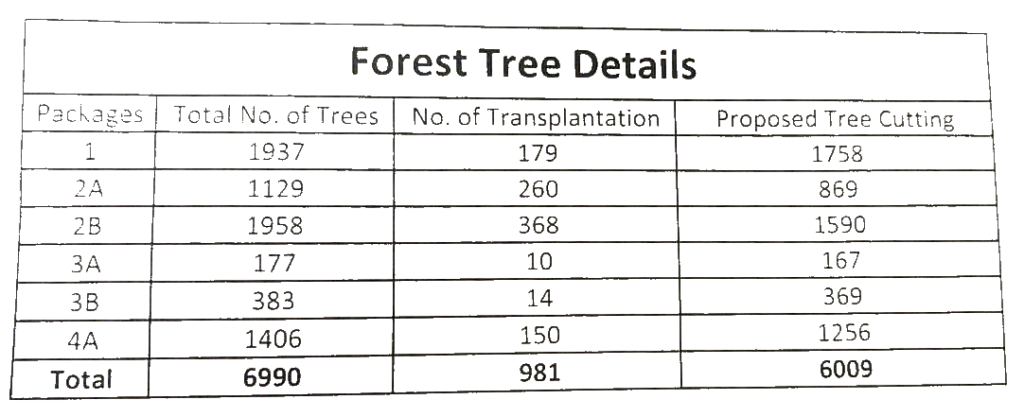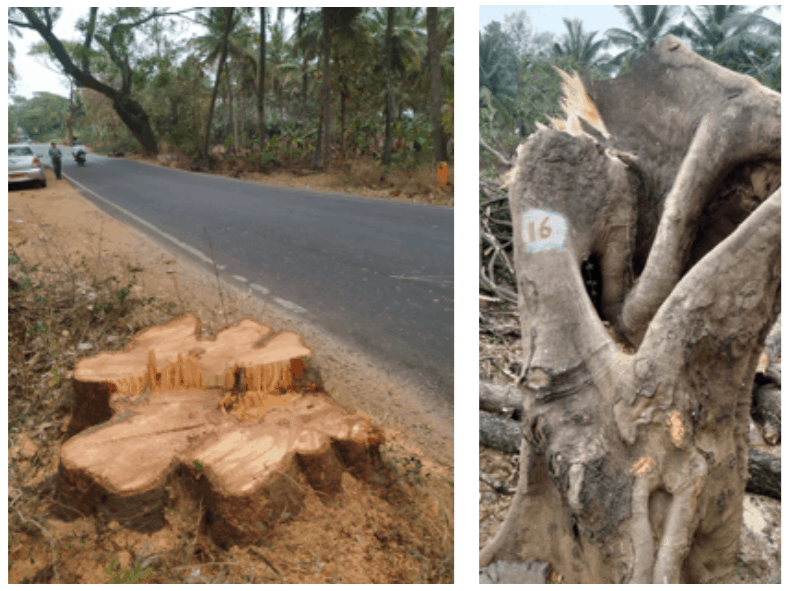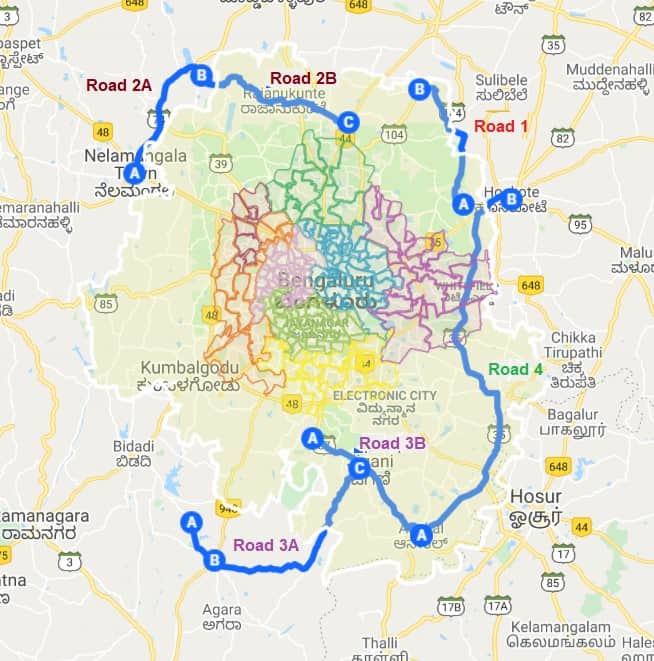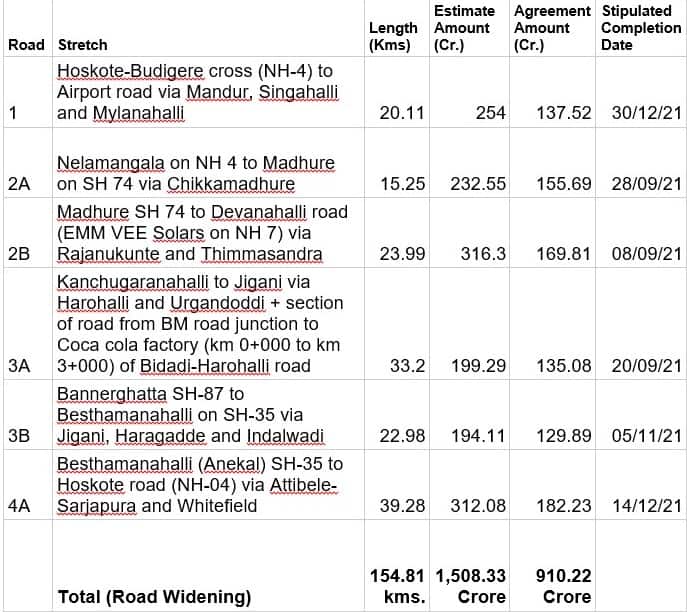Since the start of this year, there’s been much discussion about the ‘Bangalore Surrounding Roads Project’, for which thousands of trees around the city would be axed. The Karnataka Road Development Corporation Ltd (KRDCL) had proposed this road-widening project to decongest the city’s peripheral roads, and to better link different parts of Bengaluru Urban and Rural to the Kempegowda International Airport. Six roads, spanning a total length of nearly 155 km, are to be widened for the project.
Though these roads are mostly outside BBMP limits, the tree loss would have severe, long-lasting impacts for the city. But there’s been much ambiguity on how many trees would actually be felled, mainly because KRDCL and Karnataka Forest Department (KFD) have not released official information on this. The numbers cited by various sources have ranged from over 10,000 to around 6,000.
Speaking to me, Anthony Mariyappa, the DCF (Deputy Conservator of Forests) in KFD who is in charge of Bangalore Urban and Rural, says 5,390 trees are proposed to be axed, as per the latest records. Of these, 761 trees may be saved, including 628 through transplantation. The DCF is responsible for giving tree-felling permissions.
According to the document Anthony shared, KFD has already given tree-felling permissions for four out of the six road-widening packages – that is, for 3,181 trees. Permissions are pending for the remaining 2,209 trees.
That is, it’s clear that the fate of at least 3000-plus trees is already sealed. Following are the road-widening packages and the corresponding number of trees to be axed, as per details shared by the DCF.

Ramesh A, the Executive Engineer who is in charge of the project in KRDCL, says they had filed applications to the Forest Department seeking tree-felling permissions, back in April 2019. And that it was from this March that they started getting permissions and began the tree felling.
Anthony of the Forest Department says no new permissions have been granted since June. In July, KRDCL was made a respondent in an ongoing PIL preying for accountability in tree felling. Anthony adds he won’t grant new permissions until there are developments in the court case.
Numbers cited have changed over time
When the project first came into the limelight this January, several news reports said that 8,561 trees would be cut for the project. But due to the lack of transparency around the project, varying numbers have floated about since.
Early this year, a group of activists acquired a datasheet with the letterhead of KRDCL, from an unidentified employee of the organisation. This document mentions 10,451 trees to be felled. But when the same activists approached KRDCL officials later in February, “we were told the numbers were outdated,” says one of the activists, on condition of anonymity.
They were given a new datasheet with the reduced numbers of 6990 trees. Regarding this, former DCF Urban Siddaramappa Chalkapure told me that the Forest Department had asked KRDCL to reduce the tree numbers.

Are more trees being chopped than the official 5,000?
There are accounts of tree felling already happening in the Nelamangala-Madhure stretch (Road 2A), which is not yet approved by the Forest Department as per the document shared with me. A Deccan Herald report of August 15 says that 500 trees have been cut for the project on this stretch already. Contrary to the data shared by Anthony of KFD, this report says that permission to cut these trees had been granted this May.
When Mahesh Bhat, photographer and faculty at the Srishti Institute of Art, Design and Technology, drove on a 6-km stretch of this road, he too found trees cut all along. “So many of these trees were old and some were ficus [banyan] trees,” says Mahesh.
There are other discrepancies too. An independent survey by researchers at Azim Premji University (APU) in February-March found that at least a thousand trees had been marked for felling along the Kanchugaranahalli-Jigani stretch (Road 3A). This is nearly six times the currently approved number of 177.

Given these, there’s much ambiguity about the number and type of trees to be cut, as well as the approval process. KRDCL Executive Engineer Ramesh did not confirm the number of trees to be felled. He claims that KRDCL’s applications to the Forest Department were drawn up after consultations with an independent environmental expert, and that it has gone through all necessary channels. The environmental expert was unavailable for comment when contacted.
Where exactly are the roads to be widened?
The Final Feasibility Reports (FFRs) for the project, available on the KRDCL website, are as of February 2018, indicating that the project has been in the pipeline for a few years. By mid-2019, KRDCL had begun signing contracts with private consultants to work on the project. Things seemed to be underway, till the issue of tree-felling permissions came up. In addition to these six road-widening packages, the project also involves four packages for works like railway under/over bridges, and grade separators.
Following is a map showing the six road stretches to be widened, based on the FFRs.

According to the feasibility reports, around 128 acres of land has been acquired for the six road-widening projects, and this will affect at least 42 settlements along roads 1, 2A and 2B (Data on settlements affected by roads 3A, 3B and 4A are not provided in the reports).
The widening process was estimated to cost Rs 1,508 crore as per the FFRs, but work agreements uploaded by the KRDCL indicate that the cost came down to Rs 910 crore at the time of signing the contracts (Rs 5.88 crore/km).

Even as tree felling continues for the road-widening project, what is disconcerting is the complete lack of transparency and information from the KRDCL, which reduces citizen participation to a mere paper exercise. After all, how are citizens and experts supposed to provide meaningful objections and suggestions about the project without data?
[In part 2 of this series, we explore how citizens have tried to engage with this project, and why they have cause to be worried.]
NO
Yes because, the way roads are congested , people are suffering so much while drive through heavy traffic daily. This I intiative by govt is really praiseworthy.